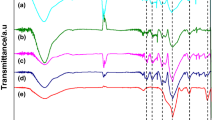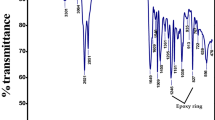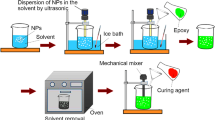Abstract
The pristine epoxy resin exhibited its low fracture toughness and low thermal stability. The using of functionalized liquid rubber led to an improvement of fracture toughness along with a reduction of thermal stability of epoxy resin. So to simultaneously improve both the fracture toughness and the thermal stability of epoxy resin the silica/PANI core-shell particles have been used as an additive. The core/shell particles were prepared by decorating the surface of silica with polyaniline via a chemical oxidation reaction. The silica was extracted from rice husk via some simple steps. The high-speed mechanical stirring was utilized to enhance the uniform dispersion of core/shell particles in epoxy resin. The composite was formed at room temperature using DETA as a curing agent. The mechanical characteristics and thermal stability of composite were examined including tensile strength, flexural strength, fracture toughness, and TGA. The tensile strength was improved by 16,16% from 40,9 MPa to 47,51 MPa by adding core/shell particles to epoxy resin. The thermal stability of epoxy resin was also improved with presence of core/shell particles. In particular, the fracture toughness was improved by 52,8% from 1,12 MPa.m−1/2 to 1,87 MPa.m−1/2. The electrical conductivity of epoxy resin with SiO2@PANI Core/Shell increased by 178 times when compared with pristine epoxy. The SEM image was also used to provide the evidence for the improvement in fracture toughness, and mechanism.
Similar content being viewed by others
Data Availability
Not applicable.
References
Zhao C, Hu Y, Guo W (2023) Enhancement of active anti-corrosion properties of waterborne epoxy resin by mussel bionic modified halloysite nanotube. Colloid Surf A Physicochem Eng Asp 675:132018
Rajsekhar V, Gattu M (2023) Size-effect testing: Nano-alumina enhances fracture toughness of epoxy resins. Theor Appl Fract Mech 125:103859
Abdukadir A, Pei Z, Yu W, Wang J, Chen A, Tang K, Yi J (2022) Performance optimization of epoxy resin-based modified liquid asphalt mixtures. Case Stud Construct Mater 17:e01598
Arena M, Vertuccio L, Barra G, Viscardi M, Guadagno L (2021) Damping assessment of new multifunctional epoxy resin for aerospace structures. Mater Today Proceed 34:180–183
Schwaiger M, Waly C, Huszar M, Oreski G, Feuchter M, Arbeiter F, Resch-Fauster K (2023) Bioinspired fracture toughness enhancement of a fully bio-based epoxy resin. Polym Test 124:108098
Yu M, Zhang T, Li J, Tan J, Zhu X (2023) Enhancing toughness, flame retardant, hydrophobic and dielectric properties of epoxy resin by incorporating multifunctional additive containing phosphorus/silicon. Mater Desig 225:111529
Mi X, Liang N, Xu H, Wu J, Jiang Y, Nie B, Zhang D (2022) Toughness and its mechanisms in epoxy resins. Prog Mater Sci 130:100977
Vu CM, Nguyen V-H, Bach Q-V (2020) Phosphorous-jointed epoxidized soybean oil and rice husk-based silica as the novel additives for improvement mechanical and flame retardant of epoxy resin. J Fire Sci 38:3–27
Bach Q-V, Vu CM, Vu HT, Vu HB, Nguyen TV, Chang SW, Nguyen DD, Thi TAD, Doan VN (2020) Significant enhancement of fracture toughness and mechanical properties of epoxy resin using CTBN-grafted epoxidized linseed oil. J Appl Polym Sci 137:48276
Bach Q-V, Vu CM, Vu HT (2019) Enhancing mode I and II interlaminar fracture toughness of carbon fiber-filled epoxy-based composites using both rice husk silica and silk fibroin electrospun nanofibers. High Perform Polym 31:1195–1203
Pham TD, Vu CM, Choi HJ (2017) Enhanced fracture toughness and mechanical properties of epoxy resin with rice husk-based nano-silica. Polym Sci Ser A 59:437–444
Xiao X, Shiqiao G, Dongmei Z, Shaohua N, Lei J, Zhuocheng O (2019) Mechanical behavior of liquid nitrile rubber-modified epoxy resin: Experiments, constitutive model and application. Int J Mech Sci 151:46–60
Serrano E, Kortaberria G, Arruti P, Tercjak A, Mondragon I (2009) Molecular dynamics of an epoxy resin modified with an epoxidized poly(styrene–butadiene) linear block copolymer during cure and microphase separation processes. Eur Polym J 45:1046–1057
Ochi M, Takemiya K, Kiyohara O, Nakanishi T (2000) Effect of the addition of aramid–silicone block copolymer on the phase structure and toughness of cured epoxy resins modified with RTV silicone. Polym 41:195–201
Zhang M, Xu H, Zeze ALP, Zhang J (2023) Metakaolin-based geopolymer composites modified by epoxy resin and silane: Mechanical properties and organic-inorganic interaction mechanism. Appl Clay Sci 232:106767
Hu X, Wang H, Zhou Z, Chen HM, Fu H (2022) Novel core-shell double microcapsules synthesize via inverse Pickering emulsion polymerization for self-healing of epoxy resin compounds. React Funct Polym 177:105317
Jian R-K, Lin X-B, Liu Z-Q, Zhang W, Zhang J, Zhang L, Li Z, Wang D-Y (2020) Rationally designed zinc borate@ZIF-8 core-shell nanorods for curing epoxy resins along with low flammability and high mechanical property. Compos B Eng 200:108349
Mao D, Chen J, Ren L, Zhang K, Yuen MMF, Zeng X, Sun R, Xu J-B, Wong C-P (2019) Spherical core-shell Al@Al2O3 filled epoxy resin composites as high-performance thermal interface materials. Compos A Appl Sci Manuf 123:260–269
Bao Q, He R, Liu Y, Wang Q, Zhang C (2023) Functionalized halloysite nanotubes endowing epoxy resin with simultaneously enhanced flame retardancy and mechanical properties. Eur Polym J 184:111797
Gunwant D, Sah LP, Zaidi MGH (2018) Fabrication and Characterization of Novel Liquid Rubber Modified Epoxies. Mater Today Proceed 5:24750–24759
Liang YL, Pearson RA (2010) The toughening mechanism in hybrid epoxy-silica-rubber composites (HESRNs). Polym 51:4880–4890
Lee M, Paria S, Mondal S, Lee G-B, Shin B, Kim S, Park S, Nah C (2022) Amphiphilic block co-polymer and silica reinforced epoxy composite with excellent toughness and delamination resistance for durable electronic packaging application. Polym 245:124679
Keller A, Chong HM, Taylor AC, Dransfeld C, Masania K (2017) Core-shell rubber nanoparticle reinforcement and processing of high toughness fast-curing epoxy composites. Compos Sci Tech 147:78–88
Thomas R, Yumei D, Yuelong H, Le Y, Moldenaers P, Weimin Y, Czigany T, Thomas S (2008) Miscibility, morphology, thermal, and mechanical properties of a DGEBA based epoxy resin toughened with a liquid rubber. Polym 49:278–294
Thomas R, Durix S, Sinturel C, Omonov T, Goossens S, Groeninckx G, Moldenaers P, Thomas S (2007) Cure kinetics, morphology and miscibility of modified DGEBA-based epoxy resin – Effects of a liquid rubber inclusion. Polym 48:1695–2171
Ozturk A, Kaynak C, Tincer T (2001) Effects of liquid rubber modification on the behaviour of epoxy resin. Eur Polym J 37:2353–2363
Siva T, Kamaraj K, Sathiyanarayanan S (2014) Epoxy curing by polyaniline (PANI) – Characterization and self-healing evaluation. Prog Org Coat 77:1095–1103
Bach Q-V, Vu CM, Vu HT, Nguyen DD (2020) Suspension of poly(o-toluidine)-coated silica-based core–shell-structured composite in silicone oil: fabrication and rheological properties at different external electric field strengths. Polym Bull 77:3563–3576
Vu CM, Bach Q-V, Vu HT, Nguyen DD, Kien BX, Chang SW (2020) Carbon-Fiber-Reinforced Epoxy Resin with Sustainable Additives from Silk and Rice Husks for Improved Mode-I and Mode-II Interlaminar Fracture Toughness. Macro Res 28:33–41
Xiaolong Zhang et al (2011) Testing method for epoxide equivalent. Chinese Patent No: CN102692443A. https://patents.google.com/patent/CN102692443A/en
Phạm Anh Tuấn, Trần Vĩnh Diệu (2022) Kỹ thuật thực hành vật liệu Polymer. Nhà xuất bản khoa học tự nhiên và công nghệ, Việt Nam
Zhao QC, Li C, She ZX, Li Q, Sun YM, Zhao FC, He JX (2021) Storage Life Evaluation and Aging Mechanism Analysis of Epoxy Resin Potting Materials. IOP Conf Ser Mater Sci Eng 1043:042060
Acknowledgements
This research is funded by Le Quy Don Technical University Research Fund under the grand number 23.1.04.
Funding
This research is funded by Le Quy Don Technical University Research Fund under the grand number 23.1.04.
Author information
Authors and Affiliations
Contributions
Cuong Manh Vu wrote the manuscript; analysis; chemical synthesis Tung Van Vu revise the manuscript; do experimental; testing.
Corresponding author
Ethics declarations
Ethics Approval
The authors declare that they have no known competing financial interest or personal relationships that could have appeared to influence the work reported in this paper.
Consent to Participate
All authors voluntarily agree to participate in this review paper.
Consent for Publication
All authors give the permission to the Journal to publish this review paper.
Competing Interests
The authors declare no competing interests.
Additional information
Publisher's Note
Springer Nature remains neutral with regard to jurisdictional claims in published maps and institutional affiliations.
Rights and permissions
Springer Nature or its licensor (e.g. a society or other partner) holds exclusive rights to this article under a publishing agreement with the author(s) or other rightsholder(s); author self-archiving of the accepted manuscript version of this article is solely governed by the terms of such publishing agreement and applicable law.
About this article
Cite this article
Vu, C.M., Van Vu, T. Influence of SiO2@PANI Core/Shell Particles on Mechanical Properties, Electrical Properties, and Thermal Aging of Epoxy Resin. Silicon 16, 25–33 (2024). https://doi.org/10.1007/s12633-023-02649-3
Received:
Accepted:
Published:
Issue Date:
DOI: https://doi.org/10.1007/s12633-023-02649-3




